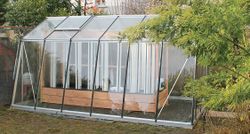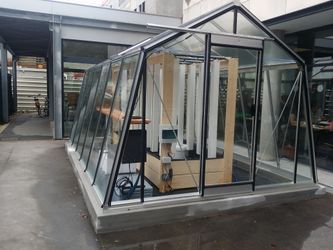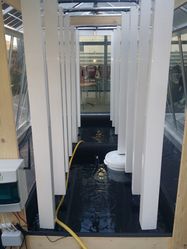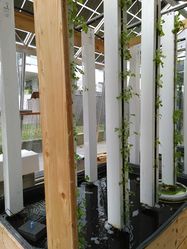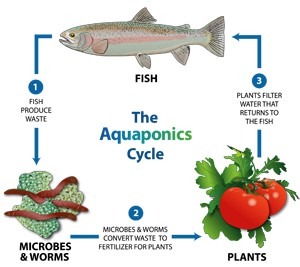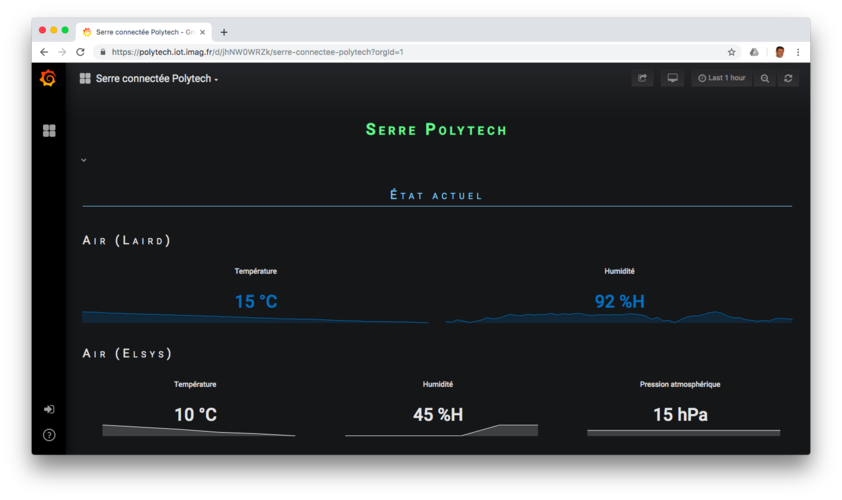ASAC/AP: Difference between revisions
(→Team) |
|||
| (45 intermediate revisions by 4 users not shown) | |||
| Line 1: | Line 1: | ||
=Brainstorming= |
|||
But du projet: Automatisation d'une serre pour la cellule humanitaire; association à but non lucratif |
|||
*Objectif principale |
|||
**Distributeur de nourriture |
|||
Pb: Dimensionnement, tube ou camembert |
|||
**Capteur Température |
|||
Air |
|||
Eau |
|||
**Communication LORA |
|||
**Niveau d'eauCapteur prêt |
|||
Reste: cache, code |
|||
*Objectif secondaire |
|||
**Capteur Nitrate |
|||
**Capteur phosphate |
|||
**Régulation ouverture automatique |
|||
This project is part of the [[ASAC]] project. |
|||
*Carte electronique |
|||
Boitier protection |
|||
= Introduction = |
|||
=Présentation= |
|||
An aquaponic greenhouse is available for projects made by engineering students from Polytech Grenoble [https://www.polytech-grenoble.fr/]. |
|||
Aquaponie: an agricultural practice combining plant cultivation and fish farming in a same place, creating a symbiotic relationship between them. |
|||
The greenhouse is also managed by the humanitarian club of the university. |
|||
[[File:serre aquaponie.jpg|250px|thumb|Greenhouse exemple]] |
|||
The projects involve students from the RICM/INFO (Computer Network and Multimedia Communication) department, the IESE (Computer Science and Electronics for Embedded Systems) department, and the MAT (Materials) department. The overall goal is also to deploy and configure various sensors, which will verify some intern parameters in the greenhouse, like air temperature and water temperature, humidity rate, or the pH of the water tank in a user friendly environment. To use the exploitation of the greenhouse, some student projects are dedicated to enhance the surrounding environment of the greenhouse with an automatic food distributor, some water tank for rain water, embellish/secure the floor or build some wicking beds. |
|||
{|style="margin: 0 auto;" |
|||
==Project== |
|||
| [[File:Greenhouse-Polytech-outside.jpg|x250px|thumb|Greenhouse@Polytech viewed from outside]] |
|||
| [[File:Greenhouse-polytech-inside.jpg|x250px|thumb|Greenhouse@Polytech viewed from inside]] |
|||
| [[File:Plantes-polytech-2019-03.jpg|x250px|thumb|Greenhouse@Polytech with plants (March 2019)]] |
|||
|} |
|||
= What is aquaponics ? = |
|||
The engineering school of Polytech Grenoble plans to install an autonomous greenhouse within its building during the academic year 2017-2018. The selected greenhouse uses the principle of aquaponie (defined above). On the long term, it will be managed by the humanitarian club of the school. |
|||
This year, the school has decided to involve the 4th and 3rd year students of IESE (Computing and Electronics Embedded Systems) and Materials sciences in this collective project.They continue the work started by the RICM (Computer Network and Multimedia Communication) in the previous year. The students have to design and perform a set of sensors in order to control parameters within the greenhouse such as the air and water temperatures, the humidity, the pH of the basins and the level of water. Another goal is to design and build an automatic food dispenser system for fish that will be growing within the greenhouse. |
|||
The term “aquaponics” comes from the link between the words aquaculture, fish or other aquatic organism farming, and hydroponic, culture of plants by the use of water rich in minerals. Therefore, aquaponics is plants and fish farming in symbioses. This type of culture was firstly used by Aztecs and Chinese. |
|||
[[File:serre aquaponie.jpg]] |
|||
Thus, we can assimilate aquaponics to an ecosystem where 3 types of organisms live in an ecologic cycle: |
|||
[[File:Schematics of the ecosystem and the organisms involved.jpg]] |
|||
* The fishes produce waste that will be used as nutriments for the plants. This waste is rich in nitrogen (ammonium and urea), in phosphor and in potassium. Elements that are essential for the plants. |
|||
To encode the sensors and perform the communication with a computer, IESE students will use a STM32 microcontroller to process all information, as well as a LoRa expansion board for the wireless platform. The idea is to employ only open-source technologies, therefore the Linux system is prefered instead of the Windows 10. The Materials students will create protections for the sensors, in collaboration with the FABLAB of the Grenoble University Campus. It’s foreseen sensors to measure the air, water and ground temperature, the humidity rate of air and ground, the pH and level of water. If time and equipment allow us, it’s aimed to measure the concentration of nitrate and ammonia in the water of the basins for more precision on the quality of the water. |
|||
* Bacterias transform the organic material, like ammonium and urea, in nitrites and then nitrates. The nitrates are in mineral form and the plants are able to use them as food. |
|||
For now, the priority is the fish food distributor. Indeed, once the greenhouse installed, it must be working as quickly as possible. The problem is that the Christmas holiday being long, our greenhouse requires a way to feed the fishes without us being present on the site. |
|||
* The plants filter the aquarium water by assimilating the minerals with their roots. In this way, the nutriments in mineral form can feed the vegetal. |
|||
In this system that we are going to set up, a water pump, powered by solar panels, will be used to transport the water with fish waste to the plants. |
|||
==Teachers== |
|||
= What is the objective of aquaponics ? = |
|||
The teacher leading the project is Nicolas PALIX.(http://lig-membres.imag.fr/palix/) |
|||
He can be helped by Benoit MARCHANT and Vincent HIBON. |
|||
Aquaponics can have different objectives depending on the desire. It can be alimentary, like vegetables and fish farming, but also for hobby or even educational. |
|||
==Team== |
|||
The main issue is to find the balance between the fish population, the food to feed them, the bacterial population and the plants farmed: an anomaly in any of these parameters can destroy the ecosystem. |
|||
In long term, this type of culture can be conceivable in large scale to overcome the problems of future food production and soil impoverishment. |
|||
{|class="wikitable" |
|||
!scope="col"| Name |
|||
!scope="col"| study class |
|||
|- |
|||
!scope="row"| Faustine MICHEL |
|||
| IESE-3 |
|||
|- |
|||
!scope="row"| Bastien BONTE |
|||
| IESE-3 |
|||
|- |
|||
!scope="row"| Paulo NAVES |
|||
| IESE-4 |
|||
|- |
|||
!scope="row"| Erik NAYAN |
|||
| IESE-4 |
|||
|- |
|||
!scope="row"| Antoine RONCO |
|||
| MAT-3 |
|||
|- |
|||
!scope="row"| Dorian REBOULLET |
|||
| MAT-3 |
|||
|- |
|||
!scope="row"| Eglantine LEJEUNE |
|||
| MAT-4 |
|||
|- |
|||
!scope="row"| Apolline LIMOUSIN |
|||
| MAT-4 |
|||
|- |
|||
|} |
|||
= Dashboard = |
|||
[[File:photo de groupe.png|200px|thumb|left|alt text]] |
|||
[[Image:polytech.iot.imag.fr.png|thumb|https://polytech.iot.imag.fr/]] |
|||
[[Image:Grafana-polytech.png|x500px|Grafana]] |
|||
= The Teams = |
|||
* [[ASAC/AP/AP-2017]] |
|||
* [[ASAC/AP/AP-2018]] |
|||
* [[ASAC/AP/AP-2019]] [https://gricad-gitlab.univ-grenoble-alpes.fr/Projets-INFO4/19-20/3/docs/-/blob/master/README.md ASAC/AP/AP-2019-INFO] |
|||
* [[ASAC/AP/AP-2020-CO]] [[ASAC/AP/AP-2020-INFO]] |
|||
= Source code repository = |
|||
https://gricad-gitlab.univ-grenoble-alpes.fr/ASAC/serre-polytech |
|||
=Project Device= |
|||
* https://gricad-gitlab.univ-grenoble-alpes.fr/Projets-INFO4/19-20/3 |
|||
* https://gricad-gitlab.univ-grenoble-alpes.fr/Projets-INFO4/18-19/4 |
|||
= Internet Links = |
|||
==The food distributor== |
|||
https://www.polytech-grenoble.fr/ |
|||
We start to think about different shapes of distibutor. Indeed, there are a lot of different parameters to look after: the type of food, the space available, the materials, the mecanism, the battery, the distribution the food inside the water... |
|||
The most commom is the circular one like illustrated on the following picture |
|||
https://myfood.eu/ |
|||
==Sensors device== |
|||
===The water level=== |
|||
===Temperature and humidity=== |
|||
===pH=== |
|||
Latest revision as of 15:47, 18 January 2021
This project is part of the ASAC project.
Introduction
An aquaponic greenhouse is available for projects made by engineering students from Polytech Grenoble [1]. The greenhouse is also managed by the humanitarian club of the university.
The projects involve students from the RICM/INFO (Computer Network and Multimedia Communication) department, the IESE (Computer Science and Electronics for Embedded Systems) department, and the MAT (Materials) department. The overall goal is also to deploy and configure various sensors, which will verify some intern parameters in the greenhouse, like air temperature and water temperature, humidity rate, or the pH of the water tank in a user friendly environment. To use the exploitation of the greenhouse, some student projects are dedicated to enhance the surrounding environment of the greenhouse with an automatic food distributor, some water tank for rain water, embellish/secure the floor or build some wicking beds.
What is aquaponics ?
The term “aquaponics” comes from the link between the words aquaculture, fish or other aquatic organism farming, and hydroponic, culture of plants by the use of water rich in minerals. Therefore, aquaponics is plants and fish farming in symbioses. This type of culture was firstly used by Aztecs and Chinese. Thus, we can assimilate aquaponics to an ecosystem where 3 types of organisms live in an ecologic cycle:
- The fishes produce waste that will be used as nutriments for the plants. This waste is rich in nitrogen (ammonium and urea), in phosphor and in potassium. Elements that are essential for the plants.
- Bacterias transform the organic material, like ammonium and urea, in nitrites and then nitrates. The nitrates are in mineral form and the plants are able to use them as food.
- The plants filter the aquarium water by assimilating the minerals with their roots. In this way, the nutriments in mineral form can feed the vegetal.
In this system that we are going to set up, a water pump, powered by solar panels, will be used to transport the water with fish waste to the plants.
What is the objective of aquaponics ?
Aquaponics can have different objectives depending on the desire. It can be alimentary, like vegetables and fish farming, but also for hobby or even educational. The main issue is to find the balance between the fish population, the food to feed them, the bacterial population and the plants farmed: an anomaly in any of these parameters can destroy the ecosystem. In long term, this type of culture can be conceivable in large scale to overcome the problems of future food production and soil impoverishment.
Dashboard
The Teams
- ASAC/AP/AP-2017
- ASAC/AP/AP-2018
- ASAC/AP/AP-2019 ASAC/AP/AP-2019-INFO
- ASAC/AP/AP-2020-CO ASAC/AP/AP-2020-INFO
Source code repository
https://gricad-gitlab.univ-grenoble-alpes.fr/ASAC/serre-polytech
- https://gricad-gitlab.univ-grenoble-alpes.fr/Projets-INFO4/19-20/3
- https://gricad-gitlab.univ-grenoble-alpes.fr/Projets-INFO4/18-19/4
